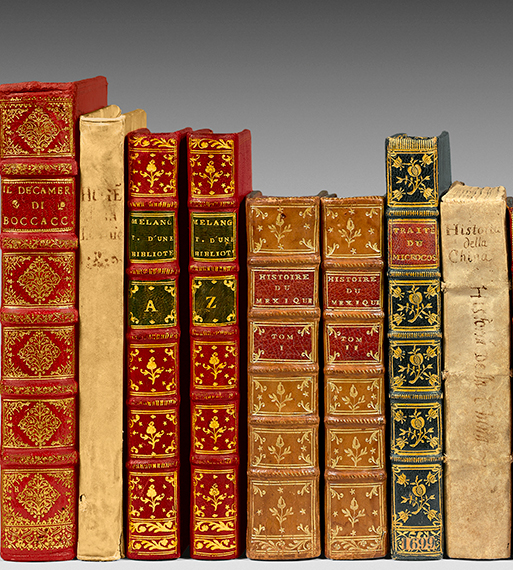« Three books stand facing the prison: Robinson, Don Quixote, and the Idiot..” (Malraux).
« There is a book that provides, in my opinion, the happiest treatise on natural education.
This book will be the first that my Émile will read: it alone will compose his entire library for a long time, and it will always hold a distinguished place there. So what is this wonderful book?
It’s Robinson Crusoe. ” (J.J. Rousseau).
Superb copy bound in morocco from Mouillé’s era.
Amsterdam, 1754.
Defoe, Daniel. The Life and Surprising Adventures of Robinson Crusoe, Ccontaining, among other eventss, the stay he made during twenty-eight years on a deserted island situated on the coast of America, near the mouth of the great River Orinoco. The whole written by himself. Translated from the English. Fifth edition.
Leiden, E. Luzac Junior, Amsterdam, Z. Chatelain et fils, 1754.
3 volumes in-12 of 1 frontispiece, xiv pp., 629 pp., 1 folded map and 6 figures out of text; (1) leaf, viii pp., 562 pp., 7 figures; xxx pp., (2), 603 pp., 7 figures.
Red morocco, smooth back adorned with small iron, triple gold frame file on the boards, decorated edges, gilt edges. Binding of the period.
164 x 95 mm.
First French translation of the Adventures of Robinson Crusoe by Juste van Effen and Themiseul de Saint-Hyacinthe. It originally appeared in 1720-1721 in another version.
Cohen, 405; Sander, 711; Sabin, 72218; Rothschild Catalogue, II, No. 1759; PMM, 180.
One of the most interesting books illustrated by Bernard Picart,
« adorned with a folded map and 21 figures by the artist, only one of which is signed.” (Cohen).
“One of the most famous books of world literature; it is the adventure of the sailor Selkirk, who had been abandoned in 1705 on the island of Juan Fernandez off Chile. After four years of solitude, he had almost returned to a wild state.
Robinson Crusoe ran away from home, embarked but his ship wrecked and, as the sole survivor, he was cast ashore on a deserted island. With incredible ingenuity, he organized his solitary existence. He meets Friday, ‘the good savage’.
Everything related to travel was extremely popular in Robinson Crusoe, to the point of masking the core of the narrative. It took Rousseau’s Émile to draw attention to what is the key idea of the work: the struggle of man alone against nature.
One thing is certain, this story is an incomparable success. “ It is Defoe, observes Jean Prévost, who prepared the marvelous emergence of realistic novels in the 18the century.” (Dictionary of Works).
« The special form of adventure that he chose and even the name of his hero have been adopted by countless imitators. At least equally relevant for the purpose is the figure of the lonely human being subduing the pitiless forces of nature; going back to nature and portraying the “noble savage” in a way that made the book required reading for Rousseau’s Emile.” (P.M.M.)
In Émile, Jean-Jacques Rousseau imagines “ a single book that alone deserves to be saved, to the exclusion of all others. Robinson Crusoe alone occupies this coveted place.” (F. Gevrey).
« There is a book that provides, in my opinion, the happiest treatise on natural education. This book will be the first that my Émile will read: it alone will compose his entire library for a long time, and it will always hold a distinguished place there. As long as our taste is not spoiled, its reading will always please us. So what is this wonderful book? Is it Aristotle? Is it Pliny? Is it Buffon? No, it’s Robinson Crusoe.” (J.J. Rousseau).
The original edition of this book, one of the most appreciated in Western literature, appeared in English in 1720. A mediocre copy was auctioned for €200,000 22 years ago. The first printing dates back to 1720-1721. Given the success of the illustrator, other editions surfaced in 1727, 1754, 1760, 1770, etc.
Copies bound in beautiful old morocco are rare and highly sought after.
Cohen cites none for the 1720 editions and only one, bound by Derôme, for this 1754 edition.
It was auctioned for FF 25,000 by Sotheby’s Monaco in 1981 and resold for FF 35,000 (€5,300) in May 1982, 41 years ago by Pierre Bérès (Cat 73 No. 114). On May 5, 2005, the 1727 similarly bound copy was sold for €18,000.
Very beautiful copy in red morocco of the time, attributable to Mouillé ” bookbinder with a confidential production ” (Ramsden, French Bookbinders 1789-1848, p. 144). Active at the end of the 18th century until 1803, this Parisian bookbinder loved to ornament his bindings with the English style that was then in vogue. Mouillé settled on Rue Saint Jacques, in the same house as Derome (Thoinan, French Bookbinders, 1893, p. 353).
Provenance: label of the Parisian bookseller Théophile Belin who owned a bookstore at 48 Rue Cambon from 1904 to 1921.
